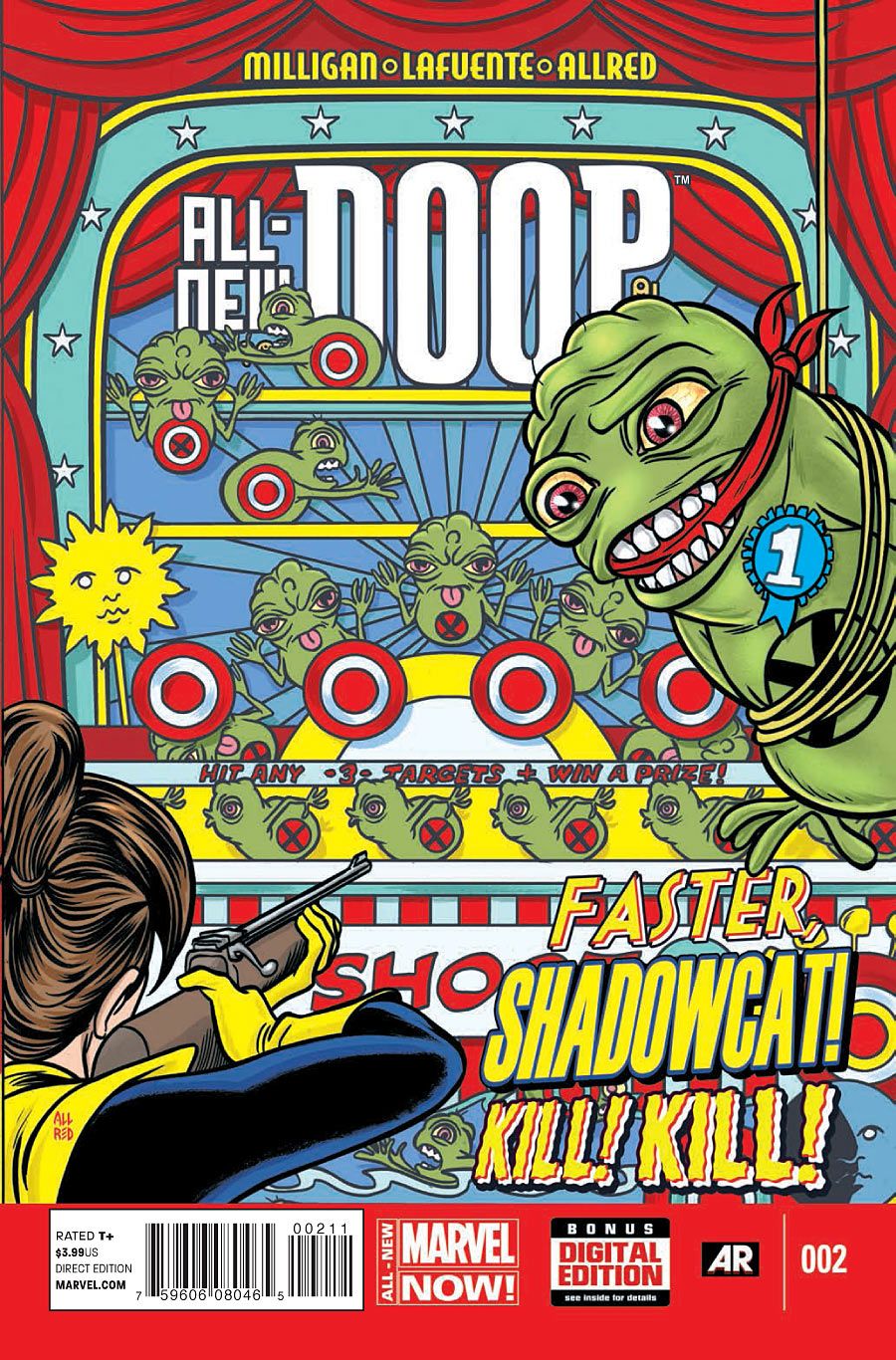In "All-New Doop" #2 by Peter Milligan and David Lafuente, Doop woos Kitty while continuing to assist in the events of the "Battle of the Atom" storyline.
The story is split evenly between these two lines of action. Doop's proposal and obsession with Kitty is the more interesting of the two, but his courtship and "date" and the details of his infatuation are whimsical and creepy, respectively. The surprise ending at the end of the debut issue doesn't turn out to be gamechanger. The real focus of "All-New Doop" #2 isn't really Doop himself but Marginalia, the space in which he lives.
This experimental exploration of comics storytelling could be so much more, and it could also be used metaphorically, to make a point about "living on the margins" and the psychological experience of being overlooked. In "All-New Doop" #2, Milligan uses the idea in a limited way, mostly to explain Doop's abilities to appear all over the place and have access to all kinds of information. This makes his powers more comprehensible, but it doesn't deepen his quirky charm or personality, and the voyeuristic aspect is unsettling.
Lafuente has a great sense of composition and beautiful linework. Even something simple like the outline of the stage for Milligan's ironic "the cinema of emptiness" is beautifully simple yet has an Art Nouveau feel. He illustrates the idea of Doop travelling through margins well with lots of white space. Allred's coloring is superb as usual and looks great within Lafuente's linework. She makes unusual and pleasing choices, like she when she lays down cerulean teal blue next to the purplish gray terrain as the background for the vehicle that Kitty and Rachel are in. Doop's "hypnotic" eyes and the shelves of a lab show an exceptional attention to detail, too.
However, some background panels feel too empty or flat, and Lafuente's anatomy feels off sometimes. The greatest weakness in art is the facial expressions. Most of the characters appear either angry or surprised, with little variation, especially for the women's faces, which all have the same pointed chin. Doop's face gets more nuanced treatment, but his expressions are cartoonish.
Milligan's script seems undecided about whether Doop is comic relief or a leading man. This doesn't assist with the reader's confusion, especially if they need a refresher on the events of the "Battle of the Atom" storyline. For those who remember those events clearly, Doop's contributions to the action slot in nicely, but aren't an essential add-on.
The focus of the series feels misplaced. Doop doesn't benefit much as a character from being written more heavily into the "Battle of the Atom" storyline, and his doomed infatuation with Kitty was never hinted at before. The reader remains an outsider to Doop. One-sided infatuations can be played for pathos, but here, the reader is more likely to sympathize with the freaked-out Kitty. It's too sad to be funny and too funny to evoke empathy.
The stand-out scene in "All-New Doop" #2 is Lafuente's interior and Milligan's imagined details of Doop's favorite restaurant, Chateau du Armpit Hair. It's a treasury of visual jokes in a half-page panel, with planters and curtains of artistically trimmed hair in a French restaurant environment. Doop and Kitty's table is in the shape of woman's razor, and there are other hilarious, beautifully illustrated details like gas masks on the wait staff and a bottle of liquor labelled "Obsolute Stinker Cachas." Lafuente's elegant linework and intricate details combine with Allred's color choices for a surreal and amusing tableau. It's too bad that the whole series doesn't hit these high notes of offbeat humor and visual splendor.
"All-New Doop" #2 dips a toe into experimenting with metafiction, but it ends up just being a footnote even for fans who want to relive the convoluted time travel shenanigans of "Battle of the Atom," and the romantic hero role doesn't feel well-structured. Lafuente's and Allred's art is worth taking a look at, but overall, having Doop as a main character hasn't been as satisfying as his previous "marginal" roles.

